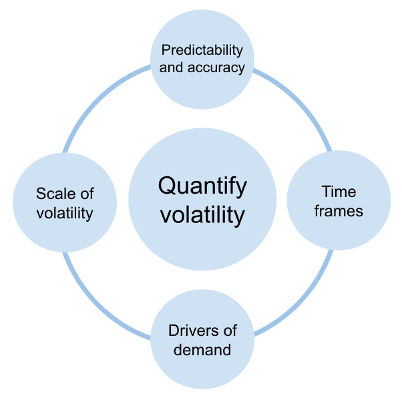Unplanned fluctuations in volumes and handling times are all too common and can wreak havoc even in the best-planned contact centre. You should not dismiss this volatility as a fact of life that must be endured; actively quantifying and understanding the drivers of volatility will enable you to:
- Prepare solutions to manage volatility, which will typically call for scheduling flexibility
- Get the buy-in of colleagues and stakeholders at all levels to these solutions;
- Future-proof your planning regime within an ever-changing business environment; and
- Create metrics that can be benchmarked with other operations.
Quantifying volatility
When quantifying volatility, there are four factors to consider, as shown in the diagram below:

Firstly, you must determine how predictable or uncertain is your need for flexibility (the knowns and unknowns - more on that below). Secondly, what is the scale of the volatility? Thirdly, when does it happen? It’s important to be clear about timeframes – in which seasons, weeks, days or periods within a day does the need for flexibility arise. Last but not least, it is vital to get an understanding of the causes or ‘drivers’ of volatility.
Analysis of volatility will help you to design better solutions - and it’s fundamental to creating a robust resourcing strategy. At the 2013 Forum conference, David Davies, former Planning Manager at Lloyds Banking Group, pointed out that fluctuations are traditionally managed by adjusting resources at short notice, anything from in real-time up to a week ahead. But is this always realistic? If you can quantify the scale of the volatility then you can quickly determine how feasible it is to respond with short-notice flexibility; 5% variability might be managed this way, but what about 20%?
The ‘Known unknowns’
The ‘known unknowns’ model has proven particularly helpful to Forum members recently. Borrowing a phrase from Donald Rumsfeld, former US Secretary of Defence, the ‘unknown unknowns’ are the factors that catch us by surprise - the more we can move things out of this category the better.
An example of an ‘unknown known’ is bad weather, which can have a major impact on operations such as insurance claims units or breakdown services. If you understand the events that can cause a spike in demand, you can prepare in advance the best way to scale up your resources. You won’t know in advance when such events are going to happen, but if you know the likely scale of the impact when they do happen, you’ll be ready to swing into action on an informed basis. Likewise, you don’t know when it will be quieter than planned, but you can be prepared with off-phone activity to make coaching or development time available at no cost to the business – a good win. Just as significantly, you can engage stakeholders and colleagues in planning the best way to react in these situations; something that is not possible when you are fire-fighting the ‘unknown unknowns’.
‘Known unknowns’ are factors which you know are going to drive demand at a particular point in time, but where there is uncertainty about the scale of the impact. This is very common in launching new products or services or planning for an event like the Olympics. We can learn by analysing forecast accuracy – particularly at interval level. If our half-hour requirements are volatile, we need to reflect that in our resourcing strategy - the more ‘noise’ the higher the staffing that we need to be confident of hitting service goals. There are two important questions to ask for all our demand drivers. First, how accurately can we predict their impact (if at all)? Second, how far ahead can we determine this (if at all)?
Scale of volatility
Quantifying the scale of volatility is fundamental to good resourcing. This is precision engineering and therefore it is vital that we get comfortable with the numbers! Take a look at this example:
Scale of volatility is calculated as (max – min)/mean staffing requirements.
Here, the average demand for a period is 300 FTE – but analysis of variation over several similar periods, reveals that staffing requirements actually fluctuate between a maximum of 350 FTE and a minimum of 250 FTE. Hence the volatility scale is 33.3% (350-250/300). Notice however that the actual value by which you need to swing your resources, depends on your resourcing strategy, which in turn depends on your organisation’s goals and objectives. There is a balance between risks and costs – it costs more to minimise resourcing risks.
Let’s ‘do the maths’. If you staff to your average (mean) forecast requirement, then you will need to swing up or down by 16.7% from this average staffing level. An alternative staffing strategy is to staff to your minimum requirement and flex up on the day, i.e. from 250 to 350 FTE. That’s a 40% swing – a major challenge!
If you staff to the maximum requirement, then it’s a 14.3% swing to come down to the average (mean) requirement. At first sight, this is the most expensive option, but it means you always have enough people rostered to deal with your demand. This might be critical, for example if you are providing outsourced services with a penalty for not complying with your Service Level Agreement (SLA).
If you have mature real-time procedures for filling quiet times with coaching and development, you can utilise the 14.3% for these activities. You can also offer unpaid leave or time-banking payback to shed the surplus resources. This kind of flexibility planning means that a low-risk resourcing strategy can actually cost the business less.
Flexibility is a team effort
Flexibility cannot be achieved by the Planning team in isolation. Management and other stakeholders need to to be on board. Clear communication of your volatility analysis will help to get the vital buy-in.
Did you find the article interesting and would like to share it with your colleagues? Download the article as a PDF.




